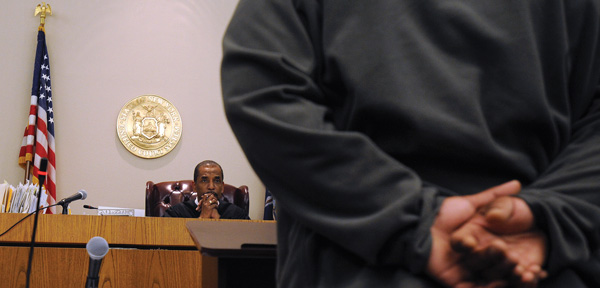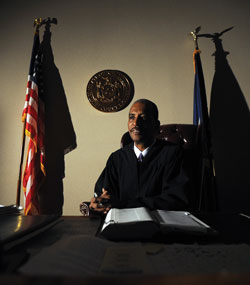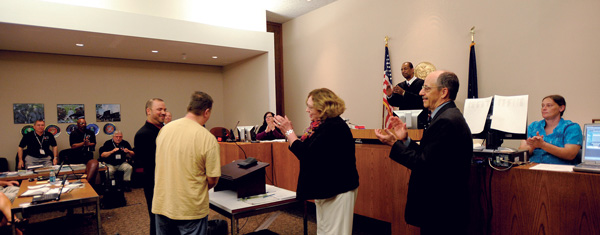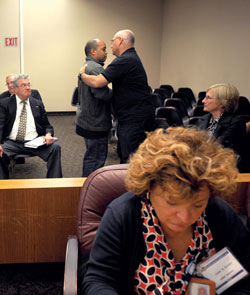The Battle on the Home Front: Special Courts Turn to Vets to Help Other Vets

Photo of Judge Robert Russell by Jennifer S. Altman.
When Assistant District Attorney Ray Herman first became involved with Buffalo, N.Y.’s alternative treatment program for military veterans who’d found themselves on the wrong side of the law, he had his doubts.
“The whole program seemed a little—I don’t know—touchy-feely,” says the no-nonsense Herman.
But slowly, case by case, what Herman saw changed his mind. “I really support this,” he says. “There’s a very, very high percentage of success with the program, which is an excellent result for everyone because these are people that are no longer going to be in trouble with the law. So the program works.”
Veterans treatment courts like Buffalo’s are sprouting in courtrooms across the country, with 80 having been established in the past 3½ years. The growth—largely independent of the federal government—has been sparked by the recognition of judges, prosecutors, public defenders and legislators that a significant number of veterans are returning from the wars in Iraq and Afghanistan with mental health issues that can manifest themselves in criminal acts both great and small, and that steering them toward treatment they may have initially rejected will benefit society in the long run.
The problems have myriad sources, many of them rooted in the horrors of war, such as the out-of-nowhere shock of explosions from hidden roadside bombs, an enemy weapon that can damage the psyche as well as the body; the stress of near-continuous combat; the long deployments, which for several years in Iraq were lengthened from a year to 15 months away from home.
For infantrymen like John Clum, the stresses took a toll upon returning home.
Clum served and fought twice in Iraq. His first combat deployment was in 2005 with the 82nd Airborne Division. The duty was rough. The unit sustained near-daily rocket and mortar attacks. His battalion lost 14 members, some of them close friends. “I was pretty tight with those guys,” Clum says.
And a second Iraq tour in 2007, after he had spent time back home in Tulsa, Okla., and gotten married, Clum says, “was far more intense than my first one.”
Clum, now 37, came home and left the Army; he didn’t realize he suffered from post-traumatic stress disorder, depression and mild traumatic brain injury.
He found a job doing construction work at oil refineries. The work took him away from home a lot, and his marriage fell apart. He had other troubles readjusting to civilian life. He “missed the guys” and, knowing they were deployed to Afghanistan, felt he had let them down by stepping away.
He started hitting the bottle.
“I was drinking every day,” Clum says. “Blackout drinking.”
He was arrested twice for drunk driving. Just before receiving a one-year suspended sentence in March 2010, Clum tried to hang himself in his jail cell.
Then he read a newspaper story about a special court program for veterans. He called his public defender, and soon he was in Judge Sarah Day Smith’s veterans treatment court in Tulsa.
Like similar courts created over the past few years across the nation, Smith’s court specializes in working with troubled veterans to get them counseling, and linking them to government treatment and other benefits they may have not known about or skipped over upon their return home. The program is aimed at helping them regain the sense of discipline and camaraderie they had in uniform, and steering them onto a more positive course in life.
Ten months into the 18-month program, Clum now takes stabilizing medication, undergoes counseling, works with a volunteer veteran mentor, auto-tests for sobriety three times a day and regularly attends Alcoholics Anonymous meetings.
“It’s a very hard program,” Clum says, but he adds that he has progressed to the point where he now plays a positive role in the lives of his son, 13, and daughter, 10. And he has a job that he found himself, installing home generators for a veteran-friendly company.
“Got a future,” he says.

Judge Robert Russell created the nation’s first veterans treatment court in Buffalo, N.Y., in 2008. Photo by Jennifer S. Altman.
COMMON BONDS
The nation’s first veterans treatment court was established in Buffalo in early 2008. Robert Russell, an associate judge for the Buffalo City Court, noticed more veterans showing up in his drug and mental health treatment courts, which he set up in 1995 and 2002, respectively.
Russell is not a veteran, but he knew that an estimated one in five veterans of the ongoing wars shows signs of mental health issues. He also saw that veterans coming before his other courts had a noticeably positive reaction to two fellow vets who worked for the court, former soldier Jack O’Connor and former Marine Hank Pirowski.
“It was, wait a minute, there’s something to this … how a veteran responds to another veteran,” Judge Russell says.
A year of planning followed, including meetings with the local Department of Veterans Affairs advisory board, which ended up producing the court’s first veteran mentors and health providers, as well as veteran advocates in the local community.
The court was born and the idea has quickly spread, as the numbers make plain. The Buffalo court is considered a model and is one of four that hosts training sessions for other courts and courts in development.
The concept is rooted in the approach of drug treatment courts such as Russell’s that now dominate the country’s more than 3,000 “problem-solving” or “collaborative” courts.
In drug courts, defendants get a chance to rehabilitate instead of serving jail time. Typically, they submit to weekly blood tests, and the courts receive status reports from teachers or employers for 12-18 months. Most drug courts do not accept violent defendants, although this varies by state.
Most defendants plead guilty to the crime, but the sentence is stayed pending completion of the program, as is the case in Buffalo.
Veterans treatment courts, hybrids of the drug and mental health treatment courts, run much the same way.
If participants stay clean and on track, they “graduate” and have their charges dismissed and records wiped clean. There are exceptions: In California, for example, convictions for crimes of violence and driving while intoxicated remain on the record after graduation.
“It’s really up to the person,” Buffalo ADA Herman explains. “And if they want to do it, help’s available and the judge is willing to work with them. But they are kind of on their own, also. Because it’s a choice they have to make. You want to clean yourself up … you’re going to have to show up to the sessions. And if you don’t, you could be in jail.”
Collaborative courts work, according to Judge Wendy Lindley of California’s Orange County Com bat Veterans Court. In a 2009 report, Lindley wrote that studies during the past 15 years show they enhance public safety, cut recidivism and are more cost-effective than the typical manner of processing offenders.
The veterans court concept, however, does not attract universal support.
Allen Lichtenstein, general counsel for the Nevada chapter of the American Civil Liberties Union, told Reuters earlier this year that, while his group recognizes that certain veterans have special needs, it opposes the establishment of what it says are, in effect, two separate systems.
“Where does it end?” asks Lichtenstein. “Do we then have courts where police are treated because of a certain status?”
The national organization, however, wholeheartedly backs the concept, says Vanita Gupta, the ACLU’s deputy legal director. “We are always on the lookout for making sure that problem-solving courts comply with procedural fairness and actually don’t end up being more punitive than the normal criminal justice system.”
But veterans treatment courts, Gupta says, “have developed a recognition that our criminal justice system is, frankly, ill-equipped to address the problems of substance abuse, chemical dependency, mental illness that really plague so many in our prisons, including the majority of veterans who are incarcerated.”
As with the drug courts, there are no national standards for admission. Generally, however, veterans must have a diagnosis of substance abuse or mental illness, such as post-traumatic stress disorder, to be admitted. Some courts, but not all, limit participation to combat veterans.

Veterans are screened for drug usage. Photo by Jennifer S. Atlman.
CONTROVERSY OVER PLEADING
Most treatment courts require pleas before accepting clients, and some observers take issue with this. Army veteran Guy Gambill of Minneapolis, a longtime advocate for veterans caught in the justice system, believes that some veterans—facing the choice between a long, court-ordered treatment program and a small fine plus six months in jail—will, despite the former’s promise of personal betterment, opt for the latter.
Gambill thinks veterans with mental illness or substance abuse issues would be far better served, as would society, if more courts offered diversion programs—that is, allowed veterans charged with nonviolent crimes to be placed into treatment without having to enter a plea.
Lindley says she’s familiar with the argument for diversion. But going in that direction, she says, takes too much off the veterans’ shoulders in the eyes of the law.
“I think that’s kind of a tough argument,” she says. “It’s my understanding that [diversion advocates] feel in cases such as, let’s say, driving under the influence, that a veteran should get a walk. And I know that law enforcement and the DA’s association feel that would be a miscarriage of justice.”
Brian Clubb, a former Marine Corps intelligence officer, attorney and public defender who now serves as the Veterans Treatment Court project director for the National Association of Drug Court Professionals, says pleas often produce better long-term results.
“It’s been shown that, actually, individuals who have pled guilty or pled no-contest tend to do better in these courts and graduate more often than individuals who are put into diversionary status,” says Clubb, whose Alexandria, Va.-based organization is the unofficial national clearinghouse for veterans treatment courts. “And for that reason, some courts have gone more to that model.”
He adds, “It’s kind of a stick. You know what’s going to happen to you if you don’t do well.”
Lindley and Clubb acknowledge, however, that in the age of the Internet, court records have taken on a life of their own.
Another difference among the veterans courts—and a further sign that the concept is still evolving—is the disparity of views on admission of those charged with violent crimes. Some courts won’t hear such cases; others do, but with significant caveats and checks. The degree of violence, the offender’s prior record and the victim’s view are all taken into account.
When Russell reviews domestic violence cases, for instance, he says it’s a matter “of distinguishing between those with a predisposition for domestic violence, and those whose behavior has changed after their service and related to their service. Because some of the symptoms related to post-traumatic stress disorder, traumatic brain injury, things of that sort, might be indicative of an expression that might result in anger—outbursts and anger … distinguishable from those who commit domestic violence before they go into the service and return home and still do the same thing.”
Lindley also accepts such cases—not, however, crimes such as murder or sexual assault—and says she doesn’t understand why all the veterans courts don’t do likewise.
“If our goal is to protect our communities and make them a safer place, then why wouldn’t we take cases of violence?” she asks.
“These things are so new,” says Matt Stiner, a former Marine and Iraq war veteran who helped set up the Tulsa court. A former veteran court mentor, Stiner now works with Clubb as the NADCP’s director of development and outreach for Justice for Vets, a division of the association. “Everybody’s trying to figure out: How do we treat these charges? They are different. They need to be looked at differently.”
COMBAT VETS ONLY?
A difference of philosophy also exists among various states and within the veterans court community over whether combat service should be a criterion for admission. One camp feels that all vets should be accepted, including those who never deployed to a war zone. The other believes the courts should admit only those with combat-related mental health issues.
Lindley’s court is limited to offenses committed as a result of substance abuse, PTSD or other problems stemming from combat service; noncombat vets are referred to the county’s other collaborative courts. The court has about 50 active participants and has seen 10 veterans graduate.
The “combat vets only” rule is not Lindley’s—it’s dictated by state law. But she agrees with it.
“What unites combat veterans is their combat,” says Lindley, whose court began about two years after Russell’s. “That experience … resonates very deeply with them. I think that if they’ve been damaged as a result of their service … in a combat zone, that ethically and morally we need to respond by offering them special services to restore them to who they were.”
In contrast, the Buffalo court and many others accept all veterans with a clinical diagnosis of serious and persistent mental health disease, or drug or alcohol addiction. Russell says all vets deserve special consideration simply for their willingness to serve and defend their nation. Russell says his court is not preferential and does not violate the constitutional concept of equal protection under the law.
“It’s not discriminatory” based on religion, race or gender, he says. “If you served in the armed forces, you can come into the program.”
The best argument for veterans courts, advocates say, is that they seem to work: 70 percent of defendants finish the programs and 75 percent are not rearrested for at least two years after, according to NADCP statistics.
None of Russell’s 56 graduates to date has been rearrested, to the court’s knowledge. Only 26 of the 202 veterans admitted to his program have dropped out before graduation due to noncompliance. Currently, more than 90 veterans are enrolled at Buffalo.

A veteran completing the program receives applause from mentors, coordinators and court personnel. Photo by Jennifer S. Altman.
FOOTING THE BILLS
The various courts are funded by way of what Clubb calls a patchwork—some limited federal grants and state grants, but more often a combination of local court system reallocations and court officials willing to work late.
The Justice Department’s Bureau of Justice Assistance provides money for five-day team training of court officials at one of four mentor court sites—Buffalo, Tulsa, and Orange and Santa Clara counties in California. The Substance Abuse and Mental Health Service Administration provides funding for the mentor courts’ administrative training costs and provides travel stipends for one-day training visits, Clubb says.
For many, however, local funds are nonexistent. Robert Wesley, a public defender in Orange County, Fla., says his district can’t afford such a court. Shannon Edmonds of the Texas District & County Attorneys Association told the Texas House Committee on Criminal Jurisprudence last year, “The big issue seems to be funding.”
THE COMING WAVE
In a 2007 report, Bureau of Justice researchers concluded that the percentage of veterans in state and federal prisons had steadily declined over the previous three decades. Veterans advocates and officials, however, fear that with a military that has been at war for almost a decade and has seen escalating numbers of veterans seeking VA mental health treatment, that trend could reverse.
A 2008 study by the Rand Corp. found that almost 19 percent of Iraq and Afghanistan vets were reporting symptoms of PTSD or major depression. Of those seeking VA treatment from fiscal years 2002 through 2009, mental disorders were listed as a possible diagnosis for 48 percent, according to the Veterans Affairs Office of Public Health and Environmen tal Hazards.
VA studies have found PTSD victims typically exhibit more aggression than nonsufferers, and symptoms can lead indirectly to criminal behavior.
“We’re seeing war veterans coming into the court in increasing numbers,” Clubb says. “If we don’t address it at the early stages, then we’re going to start seeing those young veterans on the streets, homeless, in jail … for things that could have been addressed earlier with assistance from the VA, from the services.”
Clubb says he doesn’t want to see veterans of the Iraq and Afghanistan wars “going down the same decades-long path that the Vietnam vets have.”
Many vets refuse to acknowledge they may suffer from war-related mental problems, Clubb says. For some, there’s a concern that doing so can mean more questions, treatment protocols and longer delays in getting home—the issue Gambill described. Others simply refuse to admit such problems because they can be perceived as a sign of weakness.
The courts try to cut through this stigma. In Buffalo, that effort involves Russell, court officials, the probation officer, prosecutors, public defenders, VA specialists and veteran mentors.
Senior case managers Mikel Morris and Pam LaMancuso track counseling, treatment and educational efforts so “the judge is fully aware of the participant’s progress,” LaMancuso says.
If problems arise, the first reaction typically is not punitive, Morris says, but more “What can we do to help you out?”
VA medical centers increasingly engage with these local courts to provide better, more immediate services to troubled vets.
For example, Tamekia Slaughter, a social worker in the Buffalo VA’s substance abuse program, works with Morris and LaMancuso to obtain permission for the VA to share information with the court about a veteran’s treatment. She also funnels various reports, such as urinalysis results, to Russell.
She has in-court, online access to a veteran’s VA medical history and can verify whether a vet has had a specific treatment or procedure. Some, she finds, have never signed up for VA treatment.

A mentor hugs a veteran after his court hearing. Photo by Jennifer S. Altman.
THE VETERAN CONNECTION
The real key to Buffalo’s success, observers say, lies in its mentor program. The court has a pool of more than 35 veteran mentors—from active-duty service members and younger veterans to older, retired vets—one of whom attends every court session. They give the veteran offenders someone to relate to but also can serve as adviser, facilitator and liaison with the court.
VA police detective Jason Jaskula, who served with the 1st Marine Division in Iraq, says the mentors want to hear defendants say they’re willing to work to turn themselves around. “I’ll be pretty blunt,” he says. “If you don’t want to do this … I’ve got 20 other guys that need my help.”
Danielle Maichle, a public defender with the Legal Aid Bureau of Buffalo, says the mentors’ approach works toward getting the veterans to tap into the sense of pride they had in the military. “There’s something about that pride from the past that they’re able to resurrect, and they’re able to move forward,” she says. “I’ve seen it.”
“Structure,” Lindley says. “They respond well to structure.”
A good example is Bryan, a Navy information systems technician from 2000 to 2005 and a defendant in the Orange County court. He asked that his last name not be published.

Buffalo public defender Danielle Maichle and Erie County Assistant District Attorney Ray Herman attest to the success of the alternative treatment program, which includes veteran mentors. Photo by Jennifer S. Altman.
He left shipboard duty in 2004 for a mobile communications unit serving with a special operations team in Afghanistan for six months, where he saw “a lot of … ground combat, a lot of caves.”
He got out and went home to San Clemente, Calif. Hanging around hard-charging special warfare types, he says, had rubbed off. He started working out like a fiend, taking steroids and pain pills, and drinking too much alcohol. His marriage began falling apart.
Looking to recapture that military camaraderie, he fell in with four guys who decided to go vigilante on neighborhood drug pushers.
“We were kicking down doors,” Bryan says. “We had weapons.”
Leaving the gym one day, he got pulled over. The police found steroids in his car. Though he wound up in jail, his public defender knew of Lindley’s court and got him admitted.
At first, he was resistant. “I didn’t believe I had a problem,” he says. But the court—and two stints in rehabilitation programs—got him on track, he says.
Now a new father, working a full-time job and in the final phase of the 18-month program, Bryan gives the mentors in Lindley’s court high marks and says he hopes to give something back by joining their ranks after he graduates.
William H. McMichael is the Hampton Roads, Va., bureau chief for Navy Times, a Gannett Co. newspaper. A version of this story first appeared in Military Times.



